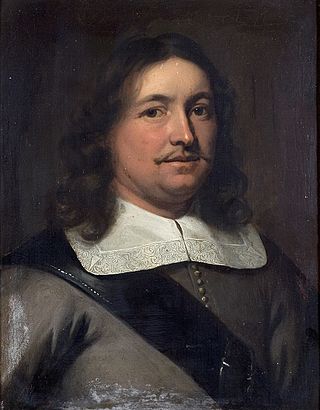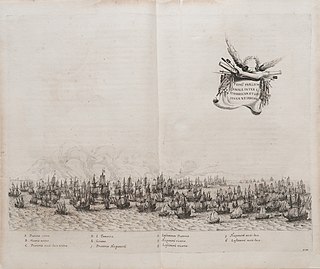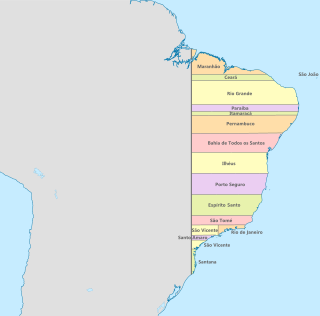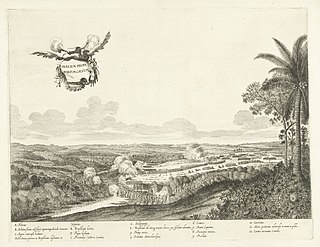
John Maurice of Nassau, called "the Brazilian" for his fruitful period as governor of Dutch Brazil, was Count and Prince of Nassau-Siegen. He served as Herrenmeister of the Order of Saint John from 1652 until his death in 1679.

The Second Battle of Guararapes was the second and decisive battle in the Insurrection of Pernambuco between Dutch and Portuguese forces in February 1649 at Jaboatão dos Guararapes in Pernambuco. The defeat convinced the Dutch "that the Portuguese were formidable opponents, something which they had hitherto refused to concede." The Dutch still retained a presence in Brazil until 1654 and a treaty was signed in 1661.

The Iberian Union is a historiographical term used to describe the dynastic union of the Kingdom of Portugal with the Monarchy of Spain, which in turn was itself the personal union of the crowns of Castile and Aragon, and of their respective colonial empires, that existed between 1580 and 1640 and brought the entire Iberian Peninsula except Andorra, as well as Portuguese and Spanish overseas possessions, under the Spanish Habsburg monarchs Philip II, Philip III, and Philip IV. The union began after the Portuguese succession crisis of 1580 and the ensuing War of the Portuguese Succession, and lasted until the Portuguese Restoration War, during which the House of Braganza was established as Portugal's new ruling dynasty with the acclamation of John IV as the new king of Portugal.

The First Battle of Guararapes took place during the Insurrection of Pernambuco, between Dutch and Portuguese forces in Pernambuco, in a dispute for the dominion of that part of the Portuguese colony of Brazil.

Dutch Brazil, also known as New Holland, was a colony of the Dutch Republic in the northeastern portion of modern-day Brazil, controlled from 1630 to 1654 during Dutch colonization of the Americas. The main cities of the colony were the capital Mauritsstad, Frederikstadt, Nieuw Amsterdam (Natal), Saint Louis, São Cristóvão, Fort Schoonenborch (Fortaleza), Sirinhaém, and Olinda.

Joost van Trappen Banckert was a Dutch vice admiral who spent most of his career in the service of the admiralty of Zeeland.

Jaboatão dos Guararapes is a city in the state of Pernambuco, Brazil. It is a part of the Recife metro area. The population was 706,867 according to the Brazilian Institute of Geography and Statistics (IBGE) in 2020, making it the second most-populous city in the state of Pernambuco and the 27th in Brazil, ahead of major Brazilian state capitals such as Cuiabá and Aracaju. The city is a very important industrial center, hosting companies like Unilever and Coca-Cola. It is bordered by Recife in the north, Cabo de Santo Agostinho on the south, and Mangue forests to the west in Moreno.

Loango-Angola is the name for the possessions of the Dutch West India Company in contemporary Angola and the Republic of the Congo. Notably, the name refers to the colony that was captured from the Portuguese between 1641 and 1648. Due to the distance between Luanda and Elmina, the capital of the Dutch Gold Coast, a separate administration for the southern districts of Africa was established at Luanda during the period of the Dutch occupation.
Jan, Johan or Johannes van Walbeeck was a Dutch navigator and cartographer during a 1620s circumnavigation of the earth, an admiral of the Dutch West India Company, and the first governor of the Netherlands Antilles.

The recapture of Bahia was a Spanish–Portuguese military expedition in 1625 to retake the city of Bahia in Brazil from the forces of the Dutch West India Company (WIC).

The action of 12–17 January 1640 was a naval battle between a Dutch fleet and a combined Spanish-Portuguese fleet during the Eighty Years' War. The battle took place on the Brazilian coast off Pernambuco and was an attempt by a fleet consisting of approximately eighty vessels transporting about 5,000 soldiers under the command of Portuguese Admiral Fernando de Mascarenhas to land reinforcements to bolster the Portuguese militia besieging the city of Recife. On 12 January this fleet was intercepted by a Dutch task force of about forty ships commanded by Willem Loos. The ensuing battle lasted with occasional breaks until the evening of 17 January, when the Spanish and Portuguese fleet retreated and sailed away to the north.

The Captaincy of Pernambuco or New Lusitania was a hereditary land grant and administrative subdivision of northern Portuguese Brazil during the colonial period from 1534 to 1821, with a brief interruption from 1630 to 1654 when it was part of Dutch Brazil. At the time of the Independence of Brazil, it became a province of United Kingdom of Portugal, Brazil and the Algarves. Captaincies were originally horizontal tracts of land (generally) 50 leagues wide extending from the Atlantic Ocean to the Tordesillas meridian.

The Fort of Santa Cruz de Itamaracá, popularly known as Fort Orange, is located on Itamaracá Island on the north coast of the state of Pernambuco in Brazil.
The Recapture of Angola, or Reconquest of Angola, was a military campaign fought between the Portuguese and the Dutch occupiers of Angola. Its most important episode was the siege imposed by the Portuguese on the far larger Dutch garrison of Luanda.
The Groot Desseyn was a plan devised in 1623 by the Dutch West India Company to seize the Portuguese/Spanish possessions of the Iberian Union in Africa and the Americas, in order that the Spanish would not collect enough money for their war against the Netherlands.

The Capture of Recife also known as James Lancaster's 1595 Expedition or Lancaster's Pernambucan expedition was an English military expedition during the Anglo–Spanish War in which the primary objective was the capture of the town and port of Recife in the Captaincy of Pernambuco in the Portuguese colony of Brazil in April 1595. An English expedition of ships led by James Lancaster sailed via the Atlantic capturing numerous prizes before he captured Recife. He held the place for nearly a month and then proceeded to defeat a number of Portuguese counterattacks before leaving. The booty captured was substantial, Lancaster chartered Dutch and French ships that were also present there thus making the expedition a military and financial success.
The following is a timeline of the history of the city of Recife, Pernambuco, Brazil.

The Campaign of Porto Calvo, alternatively recognized as the Fall of Porto Calvo, denotes a military expedition directed by John Maurice, Prince of Nassau-Siegen, aimed at the capture of Porto Calvo. This endeavor proved successful as Prince John Maurice effectively secured control over the entire region.

The Dutch invasions in Brazil, ordered by the Dutch West India Company (WIC), occurred during the 17th century.

The Insurrection of Pernambuco, also known as the War of the Divine Light, was a movement against Dutch rule in the Captaincy of Pernambuco. The revolution occurred in the course of the second Dutch invasion during the Dutch–Portuguese War and resulted in the expulsion of the Dutch from the northeast region of Brazil, followed by the reclamation of the territory by the Kingdom of Portugal.














